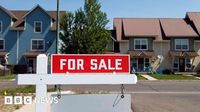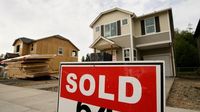New home sales in the United States soared in August 2025, defying widespread expectations and giving the housing market a jolt not seen in more than three years. According to the U.S. Census Bureau, sales of new single-family homes jumped 20.5% from July to a seasonally adjusted annual rate of 800,000 units. This figure, the highest since January 2022, also marked a 15% increase from August 2024. For an industry that has been wrestling with affordability woes and stubbornly high mortgage rates, the surge was as surprising as it was significant.
Economists had forecast a much more modest pace of 650,000 units, but the reality blew past even the most optimistic estimates. As reported by BBC, builders across the country have been ramping up discounts and other sales incentives to entice hesitant buyers, especially with an oversupply of newly constructed homes on the market. The National Association of Home Builders (NAHB) confirmed that 66% of builders used incentives such as price cuts or mortgage rate buydowns in August—the highest share seen since the onset of the COVID-19 pandemic.
"Builders remain more willing than individual sellers to adjust prices, but even with these concessions, the market is still gauging how much demand can be coaxed back," said Anthony Smith, Senior Economist at Realtor.com, in a statement cited by Nexstar Media Inc.
The surge in sales was not solely the result of builder generosity. Mortgage rates, which had been a major obstacle for potential buyers, began to ease in late summer. According to Freddie Mac, the average 30-year fixed mortgage rate slipped to 6.56% by the end of August from 6.72% in July, and then dipped further to 6.26% after the Federal Reserve cut interest rates in September. This drop, as noted by NAHB Senior Director of Forecasting and Analysis Jing Fu, was a key driver behind August’s unexpected jump. "If this momentum continues, we expect new home sales to gain traction as more buyers reenter the market in the final quarter of 2025," Fu said in a statement released by the NAHB.
While the headline numbers are eye-catching, experts urge caution. The new home sales data is notoriously volatile and subject to revision. "Take the gain with a huge grain of salt," economists at Wells Fargo advised in a research note quoted by BBC. Nancy Vanden Houten, a lead U.S. economist at Oxford Economics, echoed this skepticism, warning that the August surge "likely overstates any improvement in housing activity." The three-month moving average of new home sales, which smooths out some of the monthly noise, stood at 713,000 units in August—up from 656,000 in July, according to Advisor Perspectives.
Despite the strong month, the broader housing market remains constrained. New homes account for only about 14% of total U.S. home sales. The vast majority of transactions involve existing homes, and affordability remains a major hurdle for many buyers. As Eric Teal, chief investment officer at Comerica Wealth Management, put it to BBC, "There is pent-up demand in housing, but affordability remains out of reach for many first-time homeowners." Mortgage rates, though lower than earlier in the year, are still roughly double what many homeowners locked in during the pandemic. Combined with high prices and a weakening labor market, these factors have kept the overall market "persistently frozen."
Even as builders offered more incentives, prices for new homes crept higher. The median price of a new home sold in August was $413,500, up 4.7% from July and 1.9% higher than a year earlier, according to data from Advisor Perspectives and NAHB. Adjusted for inflation, the monthly price increase was 4.4%, but the annual change was actually a slight decline of 1.0%. The trend of new homes selling at a premium to existing homes has reversed in some markets, making new construction more competitive for buyers who can afford it.
Regionally, the South led the charge, accounting for an annual rate of 530,000 units sold. The Northeast, while still a much smaller market in absolute terms, posted the sharpest percentage gain—sales there shot up 72% from July, though the total was just 31,000 units. The Midwest saw a 13% increase, and the West recorded a 6% rise. However, on a year-to-date basis, sales were still down in the Northeast, Midwest, and West, with only the South showing a modest increase of 3.3%, as detailed in the NAHB’s late September release.
Inventory levels also shifted in response to the sales spike. The stock of new single-family homes for sale declined for the third consecutive month to 490,000 units in August, a decrease of 1.4% from July but still 4.0% higher than a year ago. At the current sales pace, the months’ supply of new homes dropped to 7.4, compared to 8.2 a year earlier. This tightening could put upward pressure on prices if demand remains strong in the months ahead.
It’s worth noting that a new home sale is counted as soon as a contract is signed or a deposit is accepted, regardless of whether the home is finished, under construction, or just a blueprint. This means the data can be a leading indicator of market sentiment, but also that it’s prone to swings and subsequent revisions. As Chen Zhao, head of economics research at Redfin, told BBC, "You do want to see another month of data before you really hang your hat on this."
Looking at the bigger picture, the U.S. housing market has seen dramatic ups and downs over the decades. New home sales as a percentage of the population peaked at 0.47% in July 2005, during the housing boom, and bottomed out at 0.09% in February 2011, amid the bust. While the raw number of new home sales is now 35.4% above where it stood in 1963, the population-adjusted figure remains 25.7% below the 1963 level, highlighting how today’s market, though rebounding, still has a long way to go in terms of broad-based demand (Advisor Perspectives).
Market watchers will be keeping a close eye on the coming months. With mortgage rates at their lowest in ten months and builders more willing than ever to make deals, there’s a sense of cautious optimism. But as always in real estate, the story is never as simple as a single month’s numbers. The National Association of Realtors will provide further insight when it releases existing home sales data for August, which could confirm—or contradict—the narrative of a housing market on the rebound.
For now, August’s figures offer a rare bright spot in a market that has seen more than its share of gloom, but the road ahead remains uncertain, with affordability, interest rates, and economic conditions all poised to shape what comes next.

